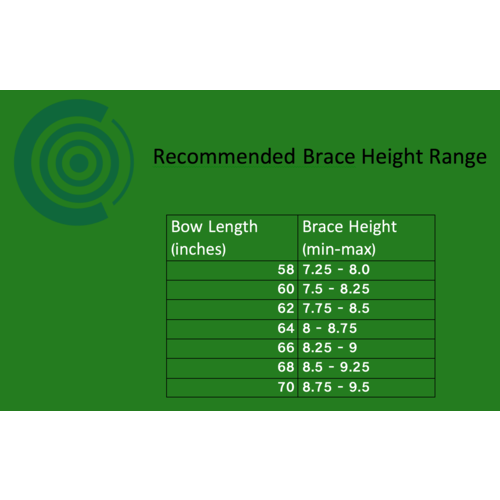Understanding Brace Height
Author: Alec Potts Date Posted:16 October 2017

Brace height is measured from the deepest part of the grip, known as the pivot point. Back to the bowstring at rest. This is also commonly in line with the Berger hole in the riser. Brace height is important for both recurve and compound bows, but different principles apply. To measure the brace height, we use a bow square. Simply clip the square onto the bowstring and measure from the string to the center of the Berger hole.
Brace height can affect the performance of your bow in two ways, the lower it is, so the closer the string is to the riser. The faster the arrow will travel; this is because the arrow will spend longer attached to the bowstring. If the brace height is higher, then the arrow will leave the string earlier, resulting in a lower arrow speed but in theory, a more forgiving bow, as there is less opportunity for the arrow to be influenced while attached to the string. Brace height is easy to adjust, by simply twisting, or untwisting the bowstring.
This chart demonstrates the most common acceptable brace height range for bows between 58 and 70 inches. So you can see that there is about a ¾” range of adjustment. But the easiest way to determine where to set your brace height, is by following manufacturers recommendations. For example, i found that I got my best results with a brace height of 9” with my Hoyt Faktor, but on my Prodigy RX, I use a brace height of 9.2” instead. So the range and final setting, will vary depending on the model and brand of bow. As a starting point, I like to take the upper half of the recommended range, and set my brace height right in the middle of that segment. So if the range recommended was 8.5-9.5, I would start with a setting of 9.25 and group tune from there.
On a compound bow, brace height tends to be less critical and as long as you stay close to the manufacturers recommendation then you’ll be fine. So don’t be afraid to fine tune your draw length, even if it means some slight changes to your brace height. And yes, this does mean you will actually have to read the instructions that come with the bow!
Checkout our Youtube video, "Understanding Brace Height"
Comments (4)
Brace height
30 May 2021Thanks for your insight. Wanted to know if this works with those shooting off the shelf as well
String twist
13 May 2021I had same problem. I tape string in normal position on lower limb, and when I unstring put the upper loop on the lower limb end. Anything thru both loops would prevent twisting. I find that brace height varies a bit until a few shots
Brace height
27 February 2020My handle is 25” and limbs is 66,68 what is the actual brace height
How to know how many twists when the string keeps
22 December 2019Thanks for the info. above. Our problem is our beeswaxed, endless loop strings keep more and more twists in it each time I unstring them, but they do unravel some as well, keeping us from knowing exactly where we really am in number of total twists, especially if we unstring often (which I think I'll avoid). Do people manually untwist the string to zero visible twists to begin again (which I doubt), or do they add more wax so it doesn't tend to untwist at all, or something else? Also, I thought endless loop was standard for Olympic, but it looks like I'm seeing people use Flemish twists. Thanks so much if you can help. Puzzled in Florida Jeff & Tina
